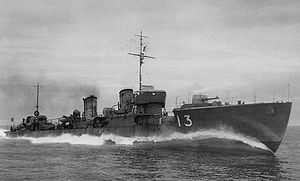Japanese destroyer Hayate (1925)
 Hayate on trials, 1925 | |
| Career | |
|---|---|
| Name: | Hayate |
| Owner: | Empire of Japan |
| Operator: | Imperial Japanese Navy |
| Builder: | Ishikawajima Shipyards, Japan |
| Yard number: | Destroyer No. 13 |
| Laid down: | November 11, 1922 |
| Launched: | March 24, 1925 |
| Completed: | November 21, 1925 |
| Commissioned: | December 1, 1925 |
| Renamed: | Hayate August 1, 1928 |
| Fate: | Sunk December 11, 1941 |
| General characteristics | |
| Class and type: | Kamikaze-class destroyer |
| Displacement: | 1,400 long tons (1,400 t) normal, 1,720 long tons (1,750 t) full load |
| Length: | 97.5 m (320 ft) pp, 102.6 m (337 ft) overall |
| Beam: | 9.1 m (30 ft) |
| Draught: | 2.9 m (9.5 ft) |
| Propulsion: | 2 shafts 4 x Ro-Gō Kampon water-tube boilers 2 x Kampon geared turbines 38,500 ihp (28,700 kW) |
| Speed: | 36.88 knots (68.30 km/h) |
| Range: | 3600 nm @ 14 knots (6,700 km at 26 km/h) |
| Complement: | 168 |
| Armament: | 3 ×Type 3 120 mm 45 caliber naval gun 10 × Type 96 25 mm AT/AA Guns 4 × 21 inch torpedo tubes 16 × naval mines |
| Service record | |
|---|---|
| Part of: | Destroyer Division 29 |
| Operations: | Battle of Wake Island |
Hayate (疾風 “Gale”)[1] was one of nine Kamikaze-class destroyers built for the Imperial Japanese Navy following World War I. Advanced for their time, these ships served as first-line destroyers through the 1930s, but were considered obsolescent by the start of the Pacific War. Hayate had the distinction of being the first major Japanese warship sunk during the war.
History
Construction of the large-sized Kamikaze-class destroyers was authorized as part of the Imperial Japanese Navy's 8-4 Fleet Program from fiscal 1921–1923, as a follow on to the Minekaze class, with which they shared many common design characteristics.[2] Hayate, built at the Ishikawajima Shipyards in Tokyo, was the seventh ship completed in this class. It was laid down on November 11, 1922, launched on March 24, 1925 and commissioned on November 21, 1925.[3] Originally commissioned simply as Destroyer No. 13, it was assigned the name Hayate on August 1, 1928.
World War II history
As part of the attack on Pearl Harbor during the opening days of World War II in the Pacific Ocean, the Imperial Japanese Navy General Staff ordered the seizure of Wake Island, then garrisoned by the United States Marine Corps. Hayate was part of Desron 6 under Destroyer Division 29 in the IJN 4th Fleet, and deployed from Truk.
Early on the morning of December 11, 1941 (in what was later termed the Battle of Wake Island, the American garrison repulsed the first Japanese landing attempts by the South Seas Force, which was screened by the light cruisers Yūbari, Tenryū, and Tatsuta; and Destroyer Division 29 with destroyers Yayoi, Mutsuki, Kisaragi, Hayate, Oite, and Asanagi; two old Momi-class destroyers converted to patrol boats (Patrol Boat No. 32 and Patrol Boat No. 33), and two troop transports containing 450 Japanese Special Naval Landing Forces troops.
The U.S. Marines fired at the invasion fleet with their six 5"/51 caliber coastal artillery guns, which had been removed from scrapped battleships, "Battery L" commanded by Sergeant Henry Bedell on Peale Islet succeeded in sinking Hayate at a distance of 4,000 yards (3,700 m) with at least two direct hits to her magazines, causing her to explode and sink within two minutes, with the loss of all hands, totaling 168 men, in full view of the defenders on shore. Yūbari was also hit eleven times, and defending aircraft sank Kisaragi during the same attack. The Japanese force withdrew before landing. This was the first Japanese defeat of the war, and also the only occasion in World War II when an amphibious assault was repulsed by shore-based guns.[4]
Hayate was struck from the navy list on January 15, 1942.[5]
References
- Brown, David (1990). Warship Losses of World War Two. Naval Institute Press. ISBN 1-55750-914-X.
- Devereaux, Colonel James P.S., USMC (1947). The Story of Wake Island. The Battery Press. ISBN 0-89839-264-0.
- Howarth, Stephen (1983). The Fighting Ships of the Rising Sun: The Drama of the Imperial Japanese Navy, 1895–1945. Atheneum. ISBN 0-689-11402-8.
- Jentsura, Hansgeorg (1976). Warships of the Imperial Japanese Navy, 1869–1945. US Naval Institute Press. ISBN 0-87021-893-X.
- Nelson, Andrew N. (1967). Japanese–English Character Dictionary. Tuttle. ISBN 0-8048-0408-7.
- Watts, Anthony J (1967). Japanese Warships of World War II. Doubleday. ASIN B000KEV3J8.
- Whitley, M J (2000). Destroyers of World War Two: An International Encyclopedia. London: Arms and Armour Press. ISBN 1-85409-521-8.
Notes
- ↑ Nelson. Japanese-English Character Dictionary. Page 629
- ↑ Howarth, The Fighting Ships of the Rising Sun.
- ↑ Nishidah, Hiroshi (2002). "Kamikaze class 1st class destroyers". Materials of the Imperial Japanese Navy.
- ↑ Devereaux, The Story of Wake Island
- ↑ Nishidah, Hiroshi (2002). "Kamikaze class 1st class destroyers". Materials of the Imperial Japanese Navy.
External links
- Nevitt, Allyn D. (1997). "IJN Hayate: Tabular Record of Movement". Long Lancers. Combinedfleet.com.
- Nishidah, Hiroshi (2002). "Kamikaze class 1st class destroyers". Materials of the Imperial Japanese Navy.
- Jones, Daniel H. (2003). "IJN Minekaze, Kamikaze and Mutsuki class Destroyers". Ship Modeler's Mailing List (SMML).
| ||||||||||||||